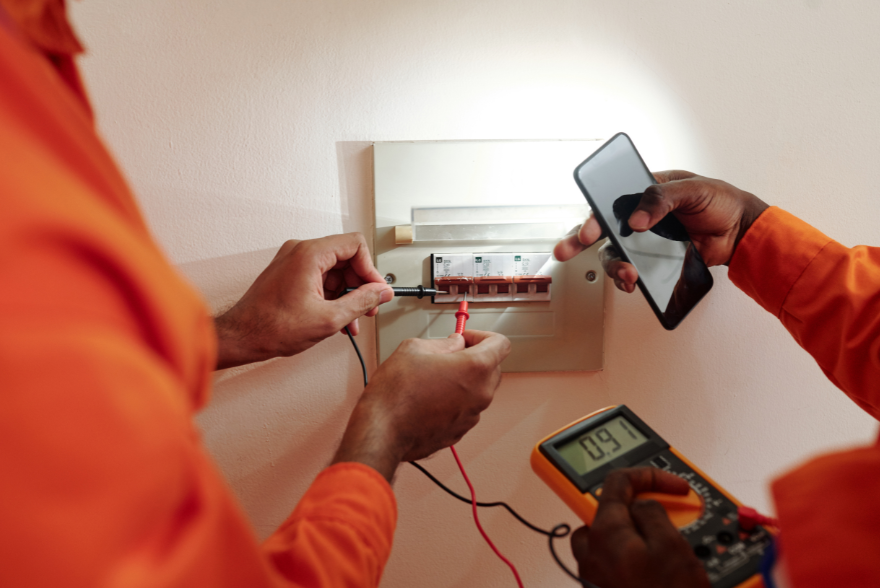What is PAT Testing?
Portable Appliance Testing (PAT) is a vital process for employers to guarantee that their electrical equipment is safe and functioning correctly. PAT testing can be performed by any competent individual, allowing many companies to manage it internally. Training employees for PAT testing can be more cost-effective than outsourcing, providing employers with better control over the process.
However, even in-house PAT testing requires time and resources. To optimise this, it’s essential to know what needs PAT testing. Misunderstanding this can lead to wasted efforts on unnecessary tests or, worse, leaving dangerous appliances unchecked.
This comprehensive guide will clarify what needs PAT testing to ensure you meet your safety obligations and maintain a secure workplace.
Understanding PAT Testing Requirements
While PAT testing itself is not legally mandated, ensuring the safety of electrical equipment is. The Health and Safety at Work Act 1974 requires employers to provide a safe working environment, encompassing electrical safety.
The Electricity at Work Regulations 1989 further stipulate that all electrical systems must be maintained appropriately. These requirements are supported by the Provision and Use of Work Equipment Regulations 1998 (PUWER), which mandate that work equipment be kept in an efficient state, working order, and good repair.
PAT testing is an effective way to meet these obligations. Around a quarter of all workplace fires in the UK are caused by faulty electrical equipment, emphasising the importance of regular PAT testing to fulfil both moral and legal duties.
What is a PAT Test?
A PAT test consists of two primary steps:
Formal Visual Inspection:
This involves a thorough examination of the appliance for any visible signs of damage or potential faults, performed by a competent person.
Testing with a Portable Appliance Tester:
This includes several tests, such as Earth continuity, insulation resistance, and leakage current tests, ensuring the appliance is safe for use. User checks, while not part of the formal PAT process, are also recommended. These basic visual assessments should be conducted by anyone using electrical devices to spot obvious issues before use.
Identifying Appliances That Need PAT Testing
Employers must ensure that all workplace appliances are safe. However, not every appliance requires a full PAT test. The necessity of PAT testing depends on the appliance class:
Class 1 Appliances:
These have basic insulation and are earthed, making them more likely to cause harm if faulty. Common examples include kettles, toasters, and power tools. The HSE recommends full PAT testing for these appliances every one to two years, with more frequent visual inspections for higher-risk items.
Class 2 Appliances:
These appliances have additional insulation, eliminating the need for an earth connection and making them safer. Examples include lamps and computers. While full PAT tests are not usually required, regular visual inspections and insulation resistance tests are advised.
Class 3 Appliances:
Low voltage, battery-powered devices like mobile phones and cameras fall into this category. They typically do not require PAT testing due to their low risk, but their chargers and cables might.
Handling Unclassified Appliances
If you’re unsure about the classification of an appliance, consult the manufacturer. If clarity is still not achieved, treat the appliance as a Class 1 item to ensure safety, but only qualified individuals should inspect the wiring.
Is PAT Testing Limited to Portable Appliances?
Despite the term, PAT testing is not only for portable items. Stationary Class 1 appliances, such as vending machines and refrigerators, also require PAT testing.
PAT Testing for New Appliances
New appliances from reputable suppliers generally do not require immediate PAT testing. However, a user check is recommended to ensure no damage occurred during transit.
Customising PAT Testing for Your Business
The frequency and extent of PAT testing should be tailored to your business’s risk level. Factors influencing this include the type of equipment, usage environment, and who interacts with the appliances. For example, office environments typically pose lower risks compared to construction sites, where equipment is frequently moved and used under harsh conditions.
Conducting PAT Testing In-House
For businesses in low-risk environments, conducting PAT testing in-house can be a cost-effective solution. Ensure the responsible person is competent and well-trained. Our online PAT Testing Course equips trainees with the necessary knowledge and skills, including step-by-step demonstrations of the PAT testing process.
Using PAT Testing Machines: Step-by-Step Instructions
1. Preparation:
>Gather Equipment: Ensure you have a PAT testing machine, labels, and a logbook or software for recording results.
>Safety First: Wear appropriate PPE (Personal Protective Equipment) and ensure the testing environment is safe.
2. Initial Setup:
>Power Up the PAT Tester: Connect the tester to a power source if required.
>Select the Correct Test Mode: Different appliances may require different testing modes (e.g., Class 1, Class 2, etc.).
3. Visual Inspection:
>Check the Appliance: Look for visible damage, such as frayed cords or exposed wires.
>Inspect Plugs and Sockets: Ensure plugs are securely attached and pins are not bent or damaged.
>Look for Labels and Ratings: Verify that the appliance matches the specifications and ratings on the label.
4. Conducting the Test:
>Connect the Appliance: Plug the appliance into the PAT tester.
>Perform Earth Continuity Test: This test ensures the earth wire is correctly connected.
>Perform Insulation Resistance Test: Checks the insulation around live parts to ensure no current leakage.
>Perform Leakage Current Test: Measures any current leaking from the live parts to the earth.
>Functional Check: Some PAT testers can perform a functional check to ensure the appliance operates correctly under load conditions.
5. Interpreting Results:
>Pass/Fail Indicators: Most PAT testers provide clear pass/fail indicators.
>Record Results: Note the test results in your logbook or software, including date, appliance ID, and test outcomes.
6. Post-Test Procedures:
>Label the Appliance: Affix a label indicating the test date and result.
>Document Any Issues: If an appliance fails, document the issue and remove it from service until repaired or replaced.
PAT Testing Procedures: Detailed Steps
Scheduling and Preparation: Plan the PAT testing session and ensure the tester is qualified. Gather user feedback to identify any known issues with appliances.
Inventory and Initial Inspection: Create a comprehensive list of all electrical equipment. Conduct visual inspections to identify any obvious defects.
Testing with Portable Appliance Tester: Perform the necessary electrical tests (Earth continuity, insulation resistance, etc.) using appropriate testing equipment.
Post-Testing Steps: Label any faulty equipment, document the findings, and provide a detailed report. Ensure defective appliances are either repaired or replaced promptly.
Tips for Effective PAT Testing
Stay Organised: Maintain an up-to-date inventory of all electrical equipment, noting their testing dates and results.
Regular Training: Ensure that the individuals responsible for PAT testing are well-trained and stay updated with the latest regulations and best practices.
Document Everything: Keep detailed records of all inspections and tests. This documentation can be crucial in the event of an incident or inspection.
Visual Inspections: Encourage regular visual inspections by all employees. Many potential issues can be identified through simple visual checks.
Understand Your Environment: Tailor your PAT testing schedule based on the risk level of your environment. High-risk areas may require more frequent testing.
Frequently Asked Questions About PAT Testing
How Often Does PAT Testing Need to be Done?
The frequency of PAT testing depends on the type of equipment and the environment in which it is used. High-risk environments, such as construction sites, may require more frequent testing (e.g., every three months), while low-risk environments, such as offices, might only need annual testing.
What is the Legal Requirement for PAT Testing?
There is no specific legal requirement for PAT testing itself. However, UK legislation, including the Health and Safety at Work Act 1974 and the Electricity at Work Regulations 1989, mandates that employers ensure the safety of electrical equipment. PAT testing is a recommended method to comply with these laws.
Can Anyone Do PAT Testing?
PAT testing can be performed by any competent person who has received appropriate training and understands the testing process. It is not restricted to qualified electricians, although they are often best equipped to handle the task.
Do You Need a Qualification to PAT Test?
While there is no formal qualification required to conduct PAT testing, the person performing the tests must be competent. This typically means having undergone sufficient training to understand the tests and use the equipment correctly. Many training courses offer certification upon completion, which can help demonstrate competency.
What is the Legal Requirement for PAT Testing?
Employers are legally required to ensure the safety of all electrical equipment under several regulations, including the Health and Safety at Work Act 1974 and the Electricity at Work Regulations 1989. PAT testing is a common and effective method to comply with these regulations, although it is not explicitly mandated by law.
Why is PAT Testing Important?
PAT testing is crucial for preventing electrical accidents, including fires and electric shocks. Regular testing helps identify potential faults before they become serious hazards, ensuring a safer working environment for all employees.
What Should be Included in a PAT Testing Record?
A PAT testing record should include the date of the test, the unique identifier of each appliance, the results of the tests (pass or fail), details of any repairs or replacements, and the next scheduled test date. Maintaining detailed records is essential for compliance and safety audits.
Conclusion
PAT testing is crucial for maintaining electrical safety in the workplace. By understanding and implementing proper PAT testing procedures, employers can ensure compliance with legal obligations and create a safer working environment. Regular PAT testing not only prevents potential hazards but also provides peace of mind, knowing your workplace is safe for everyone.



 " alt="Maintaining Patient Confidentiality: A Nursing Assistant’s Duty" />
" alt="Maintaining Patient Confidentiality: A Nursing Assistant’s Duty" />
 " alt="The Importance of Proper Body Mechanics for Nursing Assistants" />
" alt="The Importance of Proper Body Mechanics for Nursing Assistants" />
 " alt="Top 10 Essential Skills for Nursing Assistant Success" />
" alt="Top 10 Essential Skills for Nursing Assistant Success" />

